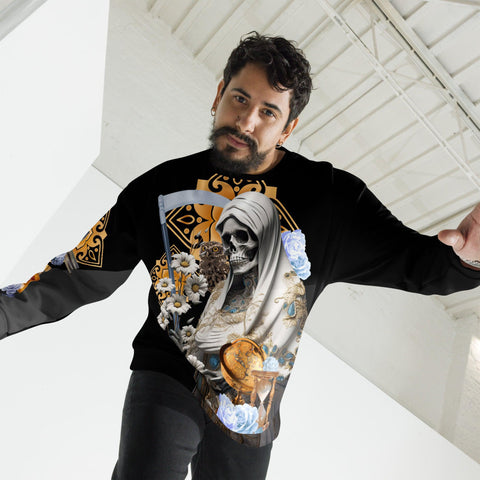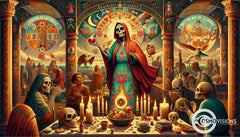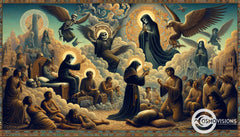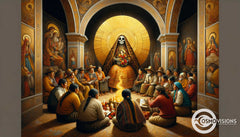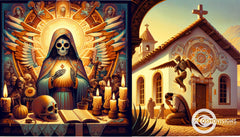Exploring the Rich Traditions of Santa Muerte Culture
Posted by Luciano Martucci

In a world brimming with diverse cultures and spiritual beliefs, it's easy to feel curious about the unusual and mystical traditions that thrive on its fringes. Imagine encountering an enigmatic figure often shadowed within mainstream dialogue, yet deeply revered by millions; an entity embodying both the benevolence of protection and the solemnity of life's end.
This is Santa Muerte, a potent symbol in many communities seeking solace beyond conventional religious practices.
Santa Muerte, Spanish for "Holy Death," captivates hearts as a folk saint who listens when others turn away. Wrapped in her allure are tales of comfort for those feeling left behind by society or traditional religion.
Our article unravels these rich tapestries surrounding Santa Muerte culture—her history, her followers' devotion in Mexico City and beyond, and why some view her as their guard against adversity.
Delve into this uncharted realm where faith defies boundaries; let’s explore how Santa Muerte's remarkable saga enfolds support for outcasts and whispers hope to the silenced. Ready to unveil secrets? Continue reading—we promise intrigue at every turn.
Understanding Santa Muerte
Santa Muerte holds a significant place in global culture, particularly within Mexican folklore. Despite opposition from church and state, the figure of Santa Muerte has become a symbol for subversive movements and marginalized communities.
The Concept of Santa Muerte in Global Culture
Santa Muerte reverberates far beyond the colorful streets of Mexico, capturing imaginations across the globe. Often depicted as a skeletal figure akin to La Catrina from Dia de Muertos, her allure combines elements of the Virgin Mary with shadows of European Grim Reaper imagery.
This powerful blend has resonated with people worldwide, leading to an expansion in worship and recognition. She stands not just as death personified but as a protective force and beacon for those seeking comfort or protection at life's margins.
Cultural currents have carried Santa Muerte's influence into diverse communities, carving out roles within LGBTQ circles, among migrants facing harsh realities, and even in spaces occupied by organized crime seeking otherworldly backing.
Her global presence defies simple categorization; it intertwines with folk Catholicism while challenging traditional religious syncretism. Devotees adorn altars with rosaries and images that reflect deep-rooted spiritual practices infused with contemporary aspirations for security and solace against life’s capricious tides.
Santa Muerte in Mexican Folklore
While Santa Muerte has a global presence, her roots go deep into Mexican folklore where she holds a profound place. She emerges as a folk saint, embodying the hardships and hopes of those often left on the fringes of society.
In art and story, this skeletal figure grips a globe or scale, symbolizing her impartial reach to all corners of human existence.
In Mexico's vibrant cultural tapestry, Santa Muerte stands out with an ambiguous reputation—both feared and loved. Here lies a paradox: while some see her as dangerous due to associations with drug trafficking and crime, countless others seek comfort in La Flaquita's embrace.
They find refuge from marginalizations that riddle their lives, offering prayers to Saint Death for protection and favor without judgment—a guardian who understands life’s darker side as intimately as its light.

Santa Muerte: Saint of the Dispossessed
Santa Muerte is often seen as the saint of the dispossessed, those who have been marginalized and oppressed by society. Despite opposition from church and state, Santa Muerte has played a significant role in subversive movements and offers protection to those who feel abandoned or forgotten.
Opposition from Church and State
The Catholic Church loudly challenges the veneration of Santa Muerte, condemning it as contrary to Christian doctrine. High-ranking officials, including Cardinals and Bishops, have publicly denounced practices related to La Santísima Muerte as dangerous and idolatrous.
They argue that such worship runs against the core teachings of Christianity and diverts the faithful from seeking intercession through officially recognized saints.
Leaders within the Mexican government also voice concerns over Santa Muerte's association with criminal elements. Law enforcement agencies see her as a figure revered by those involved in narcotics trafficking and other illegal activities.
This has led to a clash between traditional law measures and cultural expressions among marginalized communities who find solace in their faith for La Parca. Moving forward, this contention continues to shape discussions on religious freedom and cultural identity leading into "The Role of Santa Muerte in Subversive Movements.".
The Role of Santa Muerte in Subversive Movements
Santa Muerte plays a significant role in subversive movements, especially for marginalized communities such as LGBTQ migrants and undocumented immigrants. Favored by those who feel excluded or persecuted, she provides solace and protection against both church and state opposition.
Seen as a subversive figure challenging traditional religious doctrines, Santa Muerte offers refuge to those facing social exclusions and discrimination.
Devotees of Santa Muerte find empowerment and strength in her image, turning to her as a symbol of resistance against societal injustices. Her influence transcends borders, offering comfort to individuals navigating the challenges of migration while seeking spiritual support outside conventional religious structures.

The Complex Origins of Santa Muerte
Santa Muerte's origins can be traced back to a blend of indigenous beliefs and Catholicism, reflecting the complex history of Mexico. Today, she continues to serve as a symbol of security and protection in modern society.
Indigenous Beliefs and Catholicism
Indigenous beliefs and Catholicism intertwine in the complex origins of Santa Muerte. The cult's roots can be traced to pre-Columbian concepts of death, which merged with Spanish Catholicism brought by colonizers.
Some scholars claim that Mexica death cult practices evolved into the modern-day veneration of Holy Death. This malleable quality of popular Catholicism inherited from early contact between mendicant orders and indigenous people played a significant role in shaping Santa Muerte.
The fusion of indigenous beliefs and Catholicism has created a unique spiritual tradition that continues to thrive in contemporary Mexican culture, offering a fascinating insight into the syncretic nature of belief systems.
The Modern Need for Security
In today's complex world, the modern need for security has spurred the worship of Santa Muerte. As people face increasing uncertainty and challenges in their daily lives, they seek spiritual guidance and protection from unofficial icons like Santa Muerte.
This enigmatic figure has become a source of hope for many who feel marginalized and overlooked, offering a sense of security and solace in tumultuous times.
The expansion of organized crime has further fueled the belief that Santa Muerte is part of a coherent "narco-culture," adding to its mysterious identity. With investigative support programs for Santa Muerte-related killings emerging nationally, there is a growing need for understanding and addressing the influence of Santa Muerte in modern culture.
Devotion to Santa Muerte in the U. S. and Abroad
Santa Muerte has gained a devoted following in the U.S. and abroad, with many people turning to her for help in matters of love, money, and protection. Despite opposition from the Catholic Church, her influence continues to grow among those seeking guidance and support.
Santa Muerte and Catholic Faith
Santa Muerte holds a complex relationship with Catholic faith, blending indigenous beliefs with elements of Catholicism. Despite opposition from the Church, many Santa Muerte devotees still consider themselves Catholics and honor traditional saints alongside Santa Muerte.
A significant number of followers have turned to Santa Muerte due to disillusionment with mainstream Catholicism, seeking comfort in this modern deity who is believed to offer protection and assistance in matters that are often considered lost causes.
The devotion to Santa Muerte has sparked debates within the Catholic community about the compatibility of idolatrous practices and traditional Catholic doctrines. Nevertheless, for many individuals marginalized by society, including LGBTQ communities and undocumented migrants, associations between religious beliefs and social justice drive them towards embracing both their Catholic faith and the veneration of Santa Muerte as a source of spiritual solace.
Santa Muerte: The Patron for Lost Causes
Having discussed the connection between Santa Muerte and Catholic faith, it becomes apparent that she is often invoked as the patron for lost causes by her devoted followers. Many believers who have lost faith in other saints, such as Saint Jude, turn to Santa Muerte seeking assistance in hopeless situations.
The popularity of Santa Muerte echoes that of Saint Jude, the church-sanctioned patron saint of lost causes.
Santa Muerte's status as a figure for those facing insurmountable odds has made her a symbol of hope and comfort for many individuals who feel marginalized or overlooked by more traditional religious institutions.

Santa Muerte: Mysteries and Rituals
Santa Muerte plays a significant role in Mexican spirituality, with rituals and ceremonies dedicated to her involving offerings of candles, incense, and other symbolic items. The intersection of indigenous beliefs, Catholicism, and popular culture adds layers of complexity to the mysteries and rituals surrounding Santa Muerte.
The Role of Santa Muerte in Mexican Spirituality
Santa Muerte plays a significant role in Mexican spirituality, blending indigenous beliefs with Catholicism and popular culture. This unique fusion represents a source of strength and protection for many individuals living on the margins of society.
As the traditional Catholic Church has rejected certain groups, Santa Muerte has emerged as a symbol of hope and salvation for those seeking spiritual guidance outside of mainstream religion.
Devotion to Santa Muerte is often rooted in the belief that she provides benevolent influence, offering solace and protection to those marginalized by society or official religious institutions.
The Intersection of Indigenous Beliefs, Catholicism, and Popular Culture
The intersection of indigenous beliefs, Catholicism, and popular culture is evident in the syncretic origins and development of Santa Muerte, a new religious movement centered on the Mexican folk saint of death.
This cultural phenomenon represents an intersection of traditional Catholic practices and indigenous belief systems. Through the practice of providing offerings to deities, this unofficial icon has become a significant figure in Mexican popular culture despite not being officially recognized by the Catholic Church.
The syncretism present in Santa Muerte culture highlights how individuals have sought spiritual guidance and protection outside traditional church doctrines due to rejection by the conventional institution.
Understanding La Santa Muerte
La Santa Muerte is revered in Mexico as a necessary figure under the leadership of God, not seen as a Satanic symbol. The traditional Catholic Church's exclusion of certain groups has driven seekers to unofficial icons like La Santa Muerte for spiritual guidance and protection.
Unclear in origin, some believe this folk saint emerged from Spanish Catholicism merging with Aztec death worship.
The iconography and veneration of La Santa Muerte trace back to Precolumbian, European, and Latin cultures. Devotion to her is prevalent among Mexicans from the classes populäres who are deeply connected to tangible faith images.
Despite varied interpretations of her significance, she remains unrecognized as an official Catholic saint.





